From the beginning of the film Son of Man, we are introduced to the struggle that will unfold for the rest of the movie. We see that there is a conflict between Jesus and Satan, as well as a struggle for political and economic freedom. In the film, the character Jesus is represented much the same way that he is in the Gospels. Jesus gains a following of disciples, heals a dying child, resurrects a dead man, and cast a demon out of a young woman that was possessed much as he does in the stories from the Gospels. This traditional view of Jesus is tied into his being born in South Africa during a time of civil war. Jesus experiences children being beaten to death, radical groups killing others, and a constant military presence, Satan looming over each of these specific events.
The crucifixion scene is portrayed differently than in the Gospels. In the film, Jesus is brutally beaten and then carried to an open grave where he is then shot to death and buried. This is an important scene in terms of the political aspect of the film. Instead of being crucified and hung up in embarrassment, Jesus’s death is done in secret and with barely anyone there. In my opinion, it represents the secrecy and the corruption going on within the South African government at the time, in which anything or anyone that opposed them was done away with in secrecy and hidden. “Mary”, Jesus’s mother, and the disciples then take Jesus’s body and place it on the cross on a hill and use him as a symbol for their struggles.
There is a great amount of intertextuality between this film and the Gospels. As we discussed in class, the Gospels in this case would be source A and the movie would be source B. We see many different examples of this relationship including the shepherds, the disciples (excluding the women), some of the miracles he performs, his betrayal by Judas, and his being denied three times. The setting and time period of this film really solidifies Jesus as a political activist. I never thought about the urgency of the situation that he is faces with, in the Gospels and in this film.
In the movie, Son of Man, the opening scene shows good and evil presenting a conflict in power. Satan is introduced as well as Jesus, each taking their sides in the film. Satan pops up when something “evil” or bad is about to happen; a zoomed in portrait on just his face without dialog. Once the bad deed is done or as been seen, Jesus is always there correcting the deed, for example healing the boy who was dying. Jesus also plays out his role of the good power; this is exemplified through his words and deeds. Jesus says a lot about bringing peace to the world, having his disciples set aside their weapons.
Jesus’ crucifixion scene was different from traditional ideas. Jesus was beat to death and to insure his death, shot with a gun many times. His mother digs him up, out of the ground, and ties him to a cross; very different from the tomb being empty in the Gospels. Jesus raising from the dead is very vague at the end, having much more emphasis in the scene were Mary and Jesus followers are sing about darkness in the world without Jesus.
Having a modern day themed South African Jesus changes some of the ways the miracles are carried out. The stone of the adulteress is similar, but Jesus just lets her leave instead of telling the sinless to come forward. Some of Jesus’ disciples are woman, such as Simone. Jesus’s actions, words and deeds, are recorded for the African government to watch. The overall message of Jesus changes because his mission is to get people to follow him, the man who wants peace in the world.
This Jesus is different because he is born in modern day, changing the overall image of Jesus. His mission is not focused on bring people to Christianity, but to peace bringers in Africa. The movie did not seem to portray Jesus as different from the army men with guns. He was just a peace bringer. The movie changes the main motives Jesus as in the Gospels, therefore making a different Jesus and different motives.
Throughout the movie, good is represented by the child angels and evil is represented by the man in the dark clothes with the snake tattoo. It appears that they also foreshadow when something good/bad is about to happen. In this movie, the evil is the South African government that wreaks havoc on the villagers. Although they use an immense amount of violence, Jesus insists that the villagers take a peaceful approach, even making his disciples dispose of their guns.
One of the strategies used by the South African government is making people “disappear.” In one of his teachings, Jesus says “when you are told, and you will be, that people just ‘disappear,’ you must say we have been lied to;” shortly after the government reports that he has “disappeared.” When Jesus’ body is found, this signals the hope that the South African people are searching for- they don’t want people resurrected from the dead, they just want them to be found. This type of resurrection represents the justice that South Africans were seeking.
This movie is a great example of how intertextuality and ideology affect the way that we view the Gospel. Generally, the plot of the movie follows that of the Gospels. However, the South African ideology transforms the major events to reflect their culture. For example, instead of a baptism, they used circumcision which is their culture’s way of men gaining respect within their community. Intertextuality is used throughout the movie as Gospel events are changed to reflect a South African interpretation. The changing of the resurrection to something more relatable to their culture is a great example of this. A “new” Jesus is created in this movie that meets the needs of the South African people. He still teaches and performs miracles, but those that fit within the South African context.
This movie has once again challenged my preconceptions of Jesus. It is difficult to think of Jesus in any other aspect than the one that I grew up with, so initially this portrayal of Jesus is tough to grasp. However, knowing the background and culture of South Africa makes this depiction of Jesus easier to understand.
The opening scene in Son of Man sets forth a very serious manner of Jesus. He speaks with purpose and exerts his force and will upon satin by pushing him down the dune. It shows the tension and battle between the two and also foreshadows the future conflict that will arise between the two.
The crucifixion of Jesus in the film is much different from in the gospels. Instead of being beaten and put on a cross to die in front of everyone, Jesus is beaten to death in a private area. It is not a humiliation in front of the public like in the gospels. In the Son of Man Jesus is put on the cross after he has already died. Mary digs up Jesus from the grave, and puts him on the cross herself.
Placing the gospel story in South Africa brings about a new image of Jesus. In this film, the director creates a more realistic version of Jesus than some are used to. In my opinion we see a very Markian Jesus figure. Jesus shows emotion, has feelings, and gets angry from time to time. One could also argue that the depiction is more like Matthew or Luke’s story. Jesus seems to be in control, understands why he has to die, and makes no remorse about it. Looking at the film from the Gospel of John, I feel like it is definitely harder to make a connection between John’s Jesus and the Son of Man Jesus.
This movie did not change any preconceptions of Jesus that I had before watching it or taking this class. I feel like people must be careful to make sure they separate the biblical Jesus from the Jesus they read about in a fictional book or watch in a film. Sometimes the two can be blended to create a Jesus that is not based on the Bible but rather works based on the Bible. I always try to keep the two separate whenever I read a fictional book about Jesus, or watch a film on Jesus.
The main character, Jaziel portrays a Jesus figure. At the time there is a lot of crime, poverty, and unequal treatment so preaching during a time like this is not easy. He teaches his people compassion and non-violence avoiding drug companies and political hostility. As Jaziel is preaching he attracts a hand full of apostles consisting of armed rebels and women. They are all different ages, have different backgrounds, and gender. He teaches his followers about forgiving adulteresses and draws a lot of attention during the feet washing with the oil, raising a man from the dead, healing a sick boy and performing an exorcism. All of Jaziel’s miracles are portrayed in murals all over the country. At the time a new government is taking over the land and he is monitored closely by the new government. A foreign military is in the country to create peace at the time don’t seem too moved by Jaziel and his teachings but Judas secretly meets with the authorities and shows them how he is a threat to their power.
The crucifixion and resurrection part of the film was a more modern way of presenting Jesus’ death and resurrection. He was ambushed and beat up by the new government then shot and buried. The disciples then denied him and the women of the community were the ones who protested in the streets. The women who portrayed Mary went to his grave site and took out all the sticks that buried him. She brought him back to the town and hung him to the cross with t-shirts. His resurrection consisted of being taken down by a bunch of angels and celebrating with them.
In the movie, Jaziel demands peace and equality at a time when it’s not very possible where in the Bible Jesus’mission was to save the faith of the people not to necessarily preach equality. The apostles are portrayed as coming from factors of armed rebels across the country, not fisherman and tax collectors. The women in the movie play a more significant role than one seen in the New Testament. Mary seems to almost inspire Jesus instead of teaching him and there are women apostles. The Angel Gabriel
is a small African boy with glued feathers to his shoulders and Satan is in a trench coat. As a modern film Judas betrays Jaziel with a camcorder. The murals on the wall are interpretations and recordings of Jesus instead of being passed down through words.
My idea of Jesus has changed. I always viewed him as brunette with blue eyes but instead he is portrayed as a black man in South Africa who is bald and has brown eyes. Just that visual reminded me that Jesus is a universal figure.
From the very beginning of the film “Son of Man”, the director has juxtaposed two forces in the world: good and evil. Good is personified by a young African man in white robes, while evil is personified by a young African man with a snake tattoo on his face wearing black and red apparel. In fact when something bad is about to happen, Satan is always in the forefront of the camera before the deed or event occurs. The film director also uses apparel differences with the apostles to emphasize who is for and against Jesus. Judas is always wearing brown overalls while the others are wearing some shape of green on them. The film is constantly using clothing to discern good from evil.
The two, Jesus and Satan, are sitting on a dune in the desert to start off the film. From the opening line, the viewer sees what this film is about: retelling the life and death of Jesus in the political and present state of South Africa. The film is playing with intertextuality to change the viewer’s ideology of who Jesus was and what he did in a more present context with video cameras and AK-47s. From the first temptation to turn the stones into bread, I knew the story was about Jesus. After that scene, I was prepared to see how the conversation of Text A (the Gospels) would agree or vary from Text B (the movie). Having the previous knowledge of the Gospels made me look for the varying interpretation of them in this film because I knew how the story of Jesus started and ended according to my ideology of the Gospels. One example of this search for new interpretations of the plot of the Jesus story was when Jesus had his rite of passage into manhood. When Jesus became a man, I expected him to be baptized by John, but this did not occur in the film. After the rite of passage like the baptism scene, Jesus does start his ministry though, which follows the gets to the same point in the Gospel plot just by a different plot creation. This Jesus of the film values the same sort of things as the Jesus in the Gospels as well. He preaches solidarity and non-violence. He asks people to follow him in search of peace and a belief in the inherent good of others. The values of Jesus in the film bounce off the values of Jesus in the Gospels, this constant conversation of the two texts can be seen throughout the film. Jesus performs miracles as well paralleling the ones in the Gospels like healing a dying child, dead man, and possessed child. I like how the filmmaker after each major event of Jesus cut to a mural of the same deed on a wall in the streets, which tied in the culture of the film to Jesus’ story. This invention shows what this class is about: Jesus is painted in one’s own image because of culture and ideology. Jesus’ identity crosses political, geographical, and social borders constantly playing with the Gospel story to fit one’s ideology.
1. The movie was about the struggle for power in Africa. Jesus and his followers are caught in the middle of destruction, murder, and war. Satan represents the current government in Africa, which believes in creating “peace” through murdering and torturing anyone who seems to be disruptive. The Jesus in this film seems to be on more of a political mission than any other Jesus we have seen or read about. “Not all authorities are divinely instituted”, this quote from the movie brings his ideas about the condition of government in Africa to light and suggests what his mission will be.
2. Unlike in other interpretations of the Gospels, Jesus in The Son of Man does not die by crucifixion on the cross, but rather through the violence of government militia. He is later tied to the cross as a symbol for his people to rise up against the government. Rather than as a tool of death, the cross in this film is used as a symbol for a new beginning. Jesus is then resurrected as a result of the beliefs of his people and their unwillingness to back down.
3. The Jesus in this movie is placed in a more present day world rather than an older one. This helps the audience to better relate to the story. The film uses the stories of the Gospels to help tell a modern day story of revelation instead of the one we are most accustomed to. By bringing Jesus into the problems that people face today, he seems more accessible and inspirational.
4. I enjoyed the image of Jesus in this film. I feel that the film followed the telling of the Gospels accordingly while also reinventing Jesus’ purpose. The Jesus in this film was more appreciated and encouraged by the people of his country than Jesus as told by the Gospels. Although the Jesus in this film did not seem to retaliate against the military himself, being supported by his people allowed Jesus to inform and urge his followers to defend themselves.
Jesus was considered a Messiah or King of the Jewish people, ruling kings of Israel where called “anointed of Yahweh”. This also can be translated into ideal king of the future, the “anointed”one showing an expression of the inviolability of the king (1Sam. 24; 26; II Sam 1:14, 12, 19:21-H 19:22). Lamentations 4:20 turns the anointed one into “breath of our nostrils” or more easily understood as the life-giving power of God. The difference between the Messiah and an Israeli King was the role religion played; the king did not have religion at the front of the leadership. The Messiah would have two points to depart on; knowing the kingdom of David has its religious legitimation from the Nathan prophecy and that the Messiah has a son-father relationship with all it blessings. This Messiah “king” is the adopted son of Yahweh and provides the law and justice in the land. The Messiah is expected to rule forever and defeat all enemies.
The Messiah is always mentioned as a subordinate role, one that is seen more as a gift or symbol from Yahweh. The Messiah is described and labeled as strong, just, wise, and sinless. This king depends on God alone and brings a new name to the role of a king (vss. 32 ff; 18:6-9). This combination of Son of man and Messiah creates dominance that is unusual (Enoch 37-71; II Esdras; II Baruch). The time period the New Testament was written in, specifically the gospels, shows the Judaism beliefs coming out. Jewish people believed in prophecy and made their Jesus one who fulfills prophecies and suffers and dies. Jesus was viewed as someone who would raise up the Jewish people and being them a kingdom that takes away the power of the world and allow the Jewish people to have the power. The Messiah created a new type of king, one who cares for his people but also wanted to care for the world as a whole. This king did not stick to the side of this race; this Jewish King was a fill fuller of prophecy, but did not live up to the Jewish communities every wish.
John
B. Origins
Records from the Gospels of Luke tell us that John was of Aaronic decent. Like Jesus, John’s life was prophesized about before he was even born. His father Zechariah was said to have an angel appear before him that told him to name his son John. It was later prophesized that John “shall be a nazirite to God”. A nazirite is someone who doesn’t drink, doesn’t cut their hair, and has no contact with the dead. Those who followed these rules did so in order to become closer to God. According to Luke, John was raised in a rural setting and was thought to be a Galilean. John was thought to be associated with the Essenes due to multiple parallels between his ideals and theirs. For example they both emphasized repentance, thought Israel’s rules should be monogamous, and both associate God’s spirit with water. Although the similarities were numerous, John didn’t follow along with all of their teachings, making researchers believe that he may have been with them for a while and then eventually broken off.
C. Context
It is thought that John baptized people in one of two locations, the Jordan River and the Aenon. Those being baptized believed that by repenting and coming to the river to get baptized they were getting a fresh start and could once again be seen as Abraham’s true descendents. John was associated with other men who were false prophets and summon people into the wilderness to preach.
D. Message and Activities
1. John and Elijah- The way John presented himself and dressed made it seem as if he thought of himself as a prophet. Considering that the activity he was most well known for was baptizing, he was seen as John the Baptist. There are many correlations between John’s teachings and Elisha. They both reference the Jordan River, and believe in using water to be restored. John believed he was the prophet that was to come after Elisha so it was no wonder his ideas were parallel to Elisha’s.
2. John and Malachi- John’s teachings are also similar to the oracles of Malachi, both strongly disagreeing with divorce. Malachi also mentions a messenger that will prepare the way for the Lord. Many believed John to be the fulfillment of Malachi’s prophesy.
3. John and Isaiah- The most straightforward connection between John and Isaiah comes form the verse Isa 40:3, where Isaiah prophesizes a voice in the wilderness preparing the way for the Lord. There are also many verbal and thematic parallels between John and Isaiah’s writing. Words such as “coming”, “burning”, “anger” and “fire” show up in both John and Isaiah’s writing.
E. Relation to Jesus
Although there is some speculation on whether or not John baptized Jesus it is thought by researchers that it must be true due to the embarrassment principle.
F. The Death of John
John was arrested and beheaded for questioning Herod’s divorce. John’s efforts didn’t go unnoticed. Later gospel writer agreed with his ideas about baptism but emphasized that it is not right to be baptized with out repentance. The gospel writers believed that Herod killed John because he was afraid of what John’s influence over the people would do. The Gospel writers emphasize John’s idea of repentance while Josepus thought John was emphasizing morals in his teachings. Joespus and the gospels are telling similar stories about John, but just highlighting different parts of it.
G. After John's Death
John’s ideas and work are not forgotten. He is spoken about in later gospels and religious works. After his death some of his followers were “baptized in the name of the Lord Jesus”.
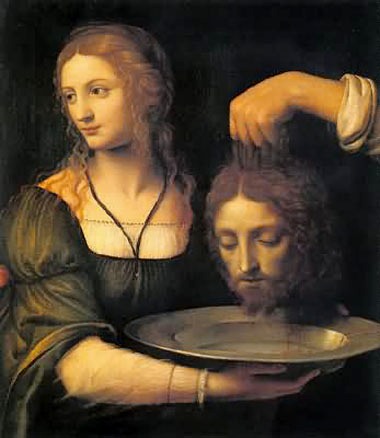 Salome and John the Baptist
CROSS
According to the New Interpreter’s Dictionary of the Bible (NIDB), the word cross has both a metaphoric and literal use (803). Literally, the word cross, in the New Testament refers to the instrument of Jesus’ death. Metaphorically, it refers to the lifestyle of the disciples, who followed Jesus in service, leading up to his crucifixion (Mark 8:34) (803). The NIDB separates the significance of the cross into three different categories including historical reality, theological significance, and spiritual/ethical significance. The first category, historical reality, refers to the humiliation and degradation that Jesus suffered to fulfill his duty to God (803-804). Cross, in this manner, also refers to Jesus’ reshaping the political norm that was established at the time through way of his death being symbolic of a martyr (804). Theologically, the cross is significant through three different areas. These include soteriology, Christology, and theology proper.
1. Soteriology deals with salvation. Salvation, as established by the New Testament, is accomplished by means of Jesus’ sacrifice on the cross. The death of Jesus, as noted by the early Christians, is described as being “for us” (804).
2. Christology deals with things that are of Christ and there interpretations. The cross, in this manner, is important because it shows Jesus’ obedience as the Son of God and reveals his identity as the Savior (804).
3. The last category, theology proper, refers to the doctrine of God. In this manner, the cross not only represents Jesus’ love but Gods love as well (804).
Spiritually and ethically, the cross is an expression of Jesus’s love and the shape and source of salvation (804).
CRUCIFIXION
Crucifixion is a means of execution where a person is nailed to a cross and left to hang there until they die (806). It was first practiced in the eastern Mediterranean and Alexander the Great and his successors were noted as using the practice (806). It was usually reserved for “murderous or rebellious slaves” (806). It was also practiced by Jewish authorities, one such being Alexander Jamaeus who is said to have crucified a number of Pharisees (806). Those that were crucified were posted along highways, hills, and city gates. These were the places that were the most traveled or the most populated so that they could act as deterrents for others who considered rebellious of deviant activities and were carried to their locations by those that were condemned to die on them (806). Victims were usually beaten and then nailed to the cross by their hands and ankles (806). The practice was later used on Christians. Some cross and their individuals carried a titilus, which declared the name and the punishment of the criminal. The titilus for Jesus was written in multiple languages and stated “king of the Jews” (806). It was considered to be the “worst form of death” at the time (807).
|

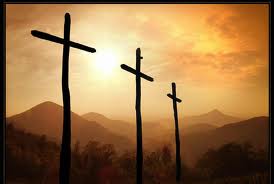
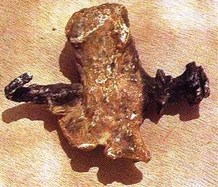
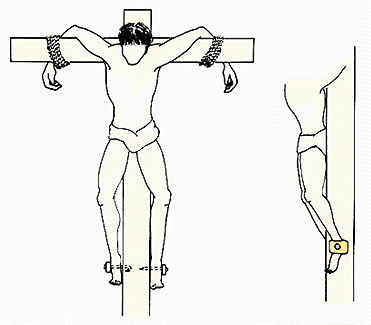
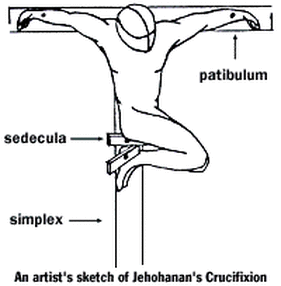
 RSS Feed
RSS Feed